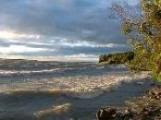Ministry to poison brook
Ministry to poison brook
Scientists take drastic measures to stop spread of round goby into Lake Simcoe
Oct 13, 2005
Provincial scientists are going to poison a five-kilometre stretch of Pefferlaw Brook next week to kill the round goby.
Representatives from the Ministry of Natural Resources at a public meeting last week revealed they will take the unprecedented measure to prevent the spread of the foreign invading fish into Lake Simcoe, where it could devastate the $200-million recreational fishery.
They will use the pesticide Rotenone to kill all gill-breathing species in the river, but remove as many native fish as possible beforehand by using a stunning electroshock and transfer them out of the treatment area. Cages holding fish will be monitored during the treatment period to ensure there is a 100-per-cent kill rate, the audience was told.
Electroshock is not effective to remove gobies because they do not have a swim bladder and will not float to the surface.
Ministry scientist Peter Waring said other options to eradicate the round goby, first found in the river last year, were considered, but the use of Rotenone was the only effective one.
The voracious invader "has got a number of things that scare the hell out of me, quite frankly. This is not like anything we have in this part of the world," Mr. Waring explained.
Since being discovered below the dam last year, gobies have since been found near the mouth of Pefferlaw Brook within sight of the lake.
Mr. Waring warned if action isn't taken, the goby will be in the lake next year and beyond any control measures.
Other species, fowl and wildlife are not affected and there is no danger to human beings, although residents were cautioned to stay off the water. Boaters who have to use the river will be escorted by conservation officers.
The river is home to three major marinas, part of the Peninsula Resort, the Church of the Nazarene camp and many homes with personal docks. The lake, just off the mouth of the river, attracts thousands of American anglers every year.
The cost of the Rotenone alone will be at least $50,000.
The chemical will be applied by specialists from the department of Fisheries and Oceans tentatively starting Monday and lasting two to three days.
Between 80 and 90 per cent of fish are expected to be caught and live released. There will be disposal sites run by volunteers from the Pefferlaw Anglers Club and the Georgina Sportsman Alliance.
Handling dead fish is not a hazard, the audience was assured. The chemical is expected to dissipate in hours and, used as directed, poses no hazard to the public, literature given to the audience stated.
However, Peter Sibbald Brown of the Lakewatch Society warned after the meeting the experiment is fraught with danger.
"We are very concerned with the lack of a risk assessment and the fact that a screening -- being the lowest level of environmental assessment -- is under way," he said.
Rotenone contains a "litany of toxic petro-chemicals, volatile organic compounds and carcinogens that will also end up in the water and the air, he added.
Government scientists "can't provide substantive evidence that this risky chemical experiment will eradicate goby from these waters", he said.
"Liquid rotenone treatment has gone wrong before and often," he said, citing a case on Utah's Freemont River in 1991 that killed aquatic life along a 35-mile stretch, including sections of Capitol Reef National Park.
Round gobies are a European import first found in the St. Clair River in 1990, where they were dumped with a ship's ballast, said Francine MacDonald of the Ontario Federation of Anglers and Hunters.
They have become the dominant fish species in Lake Erie with their insatiable appetite, aggressive behaviour and ability to spawn several times in a season. They successfully compete with native species such as perch and bass for food and habitat and eat their eggs.
They have become so numerous in parts of lakes Erie and Ontario that 100 have been measured in one square metre.



